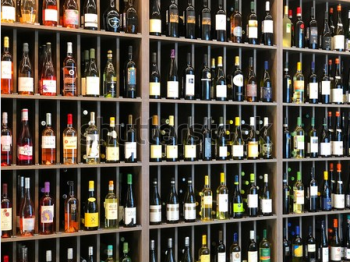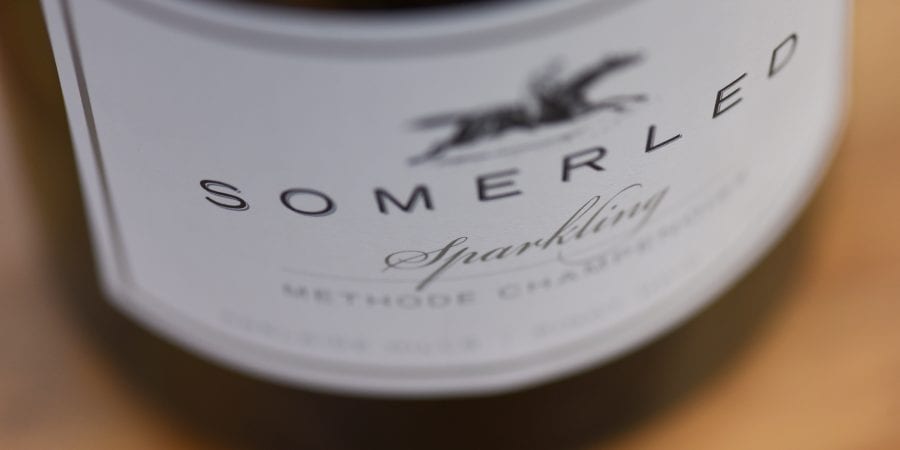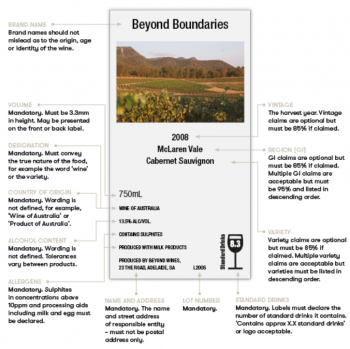We’re getting very close to bottling a few more 2018 vintage wines.
It got me thinking about all the things that go into presenting a wine for sale. It needs a bottle, a closure of some description (cork or cap) and most importantly… a label.
 Now, labels come in all shapes and sizes (literally), but even if you want to get a bit creative with your wine label there are a few Federal and State laws, regulations and Acts you need to adhere to, including…
Now, labels come in all shapes and sizes (literally), but even if you want to get a bit creative with your wine label there are a few Federal and State laws, regulations and Acts you need to adhere to, including…
- Wine Australia Act 2013
- Wine Australia Regulations 2018
- Food Standards Code
- National Trade Measurement Regulations 2009
- Competition and Consumer Act 2010
- State Consumer Laws
The bits you HAVE to include…
 Volume
Volume
It can be presented on the front or the back label but it must be 3.3mm in height for a standard 750mL bottle of wine.
Designation
The Food Standards Code requires an appropriate name or description on a label. While there are no prescribed names, it must represent the true nature of the product.
To be called “wine”, the bottle must contain no less than 700 mL/L (70%) of wine!
Country of Origin
The name of the country must be included on the label. You will often see the words “Wine of Australia” or “Australian Wine” which covers off both the country of origin AND designation requirements
Alcohol Content
According to the Food Standards Code, an alcohol statement is mandatory for foods containing greater than 0.5% alcohol by volume. For a food (which includes alcoholic beverages) that contains more than 1.15% alcohol, it must be expressed as X% alcohol by volume (or something similar).
Allergens
As of 20 December 2002, all wines (and food for that matter) are required to carry an allergen declaration.
Under the Food Standards Code these are the additives and processing aids which are listed as allergenic substances:
- Added sulphite (preservative);
- Casein and potassium caseinate (fining agent);
- Egg white (fining agent);
- Milk and evaporated milk (fining agent);
- Nuts (tannin made from chestnuts can be added to wines).
Name and Address
The name and physical business address of the Australian manufacturer must be included on the label.
Lot Number
Lot marking is necessary to in the event of a recall for health or safety reasons. If a product is not lot marked then all product carrying the same label may be compulsorily recalled by health authorities instead of just the affected batch.
Standard drinks
A standard drink is defined as the amount of beverage which contains 10 grams of ethanol, measured at 20°C. The formula for the calculation is:
- container volume (litres) x % alcohol/vol (mL/100mL) x 0.789 (specific gravity of ethanol) = the number of standard drinks.
For example, a 750mL bottle which is 14% alc/vol would be calculated:
- 0.75 x 14 x 0.789 = 8.28, rounded to one decimal place = 8.3 standard drinks.
Handy to know! I’m sure no one will think it’s strange when you whip out your calculator and measuring jug at your next dinner party.
The optional bits…
Vintage
The vintage is the year in which the grapes were harvested. Unless they were picked between September 1 and December 31 and then you use the next calendar year (don’t ask me why?!).
Variety
The variety of wine can be included on the label as long as it’s on this list.
Geographical Indications
A Geographical Indication (or GI) is a word or expression used in the description and presentation of a wine to indicate the country, region or locality in which it originated. A list of the protected GI’s and other terms can be found here.
 HOWEVER, if you do choose to include any of these on the label, then you need to adhere to something called the Australian Blending Regulations.
HOWEVER, if you do choose to include any of these on the label, then you need to adhere to something called the Australian Blending Regulations.
Basically, the regulations say that if you want to include a SINGLE vintage, variety and/or Geographic Indication then there must be at least 85% of it in the wine.
So let’s take our 2017 Somerled Pinot Noir Rose for example. It has to be made form at least 85% of Adelaide Hills Pinot Noir harvested in 2017 for us to make those claims on the label.
Claiming multiple vintages, varieties and Geographical Indications gets a bit trickier, but there are some pretty stict rules. Click on the table above to find out more.
One last thing…
The Winemakers’ Federation (WFA) recommends that all Australian winemakers include a voluntary pregnancy warning on labels of wine sold in Australia.
Although this initiative is not mandatory it is highly recommended.
#CRUSH2019
Have you got your tickets to our Crush event yet (or any of the dozens of other events throughout the region for that matter?)?
Saturday is now officially sold out, but there are a couple of spots left on Sunday 27th January!
Check it out here.

 Volume
Volume